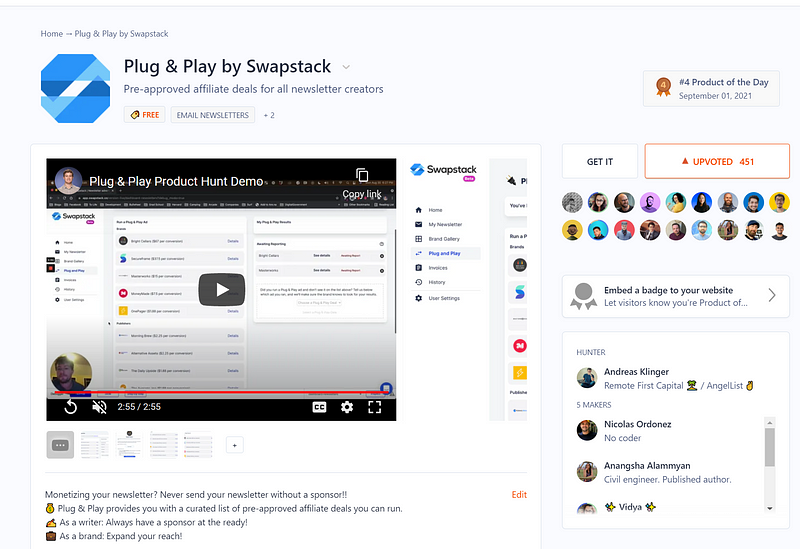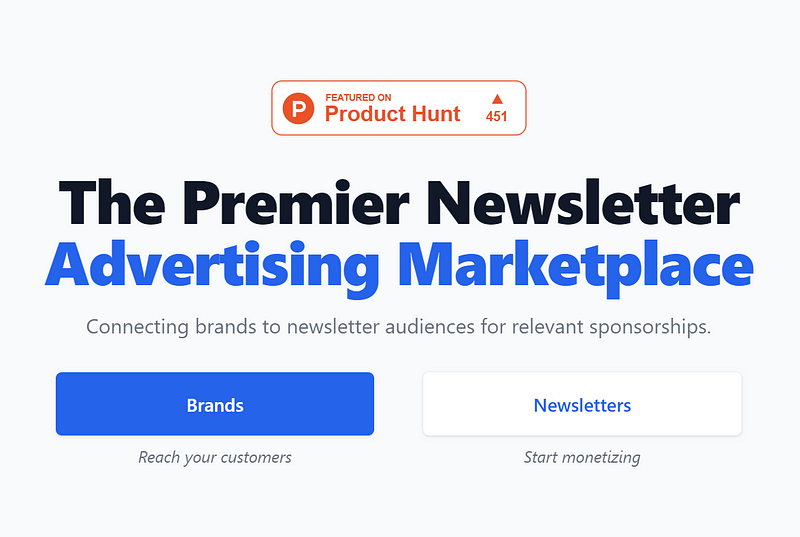What Goes on Behind the Scenes of A Successful Product Hunt Launch
Stats, metrics, and observations from Swapstack’s Plug & Play launch that ended up as #4 Product of the Day on Product Hunt

Stats, metrics, and observations from Swapstack’s Plug & Play launch that ended up as #4 Product of the Day on Product Hunt
Plug & Play by Swapstack is a curated list of pre-approved affiliate deals you can run anytime on your newsletter, social media, or blog posts.
With a huge boom in the creator economy, this can be a powerful tool in every writer’s arsenal. With Plug & Play, no writer ever has to publish content without a high-quality brand sponsoring them.
I work on content marketing for Swapstack, and on September 1, 2021, we launched Plug & Play on Product Hunt. It ended up as the #4 product of the day and got us 100+ new users in 24 hours.
Almost a month after the launch, it’s a great time to reflect on the stats and learnings. Initially, I’d read through countless guides and “how-to”s about successful Product Hunt launches. I know how frustrating it can be to sort through all of them to find anything relevant.
In this article, I’m sharing our results and what worked for us, instead of the “growth hacks” other articles promise. If you’re planning to launch your product on Product Hunt soon, this article takes a behind-the-scenes look at all the variables that fuelled Swapstack’s successful Product Hunt launch and how you can replicate the same for your product.
First of all, what is Product Hunt and who should use it?
As business builder, Peep Laja, puts it, “Product Hunt is a community-based website that allows makers and marketers to launch their products or services and get in touch with their first real users. The community can jump-start products through votes and (honest) reviews, which are essential in the early stages of campaigns. Product Hunt is free, and, often, influencers are happy to test your product, even if it’s in an MVP stage or has bugs.”
Aside from the initial traction and new user base, if your product launch is successful, there are some added perks, including:
- Shout-out on Product Hunt’s official Twitter page with 450,000+ followers.
- Mentions in their newsletter that reaches hundreds of thousands of readers every day.
- Press coverage and the possibility of attracting investors.
Now that we’ve covered the basics, let’s take a look at Swapstack’s results and what every entrepreneur can learn from them.
Swapstack’s results
The numbers here represent the results only from referral traffic from Product Hunt. In reality, the total website views and signups were much higher, thanks to the increased visibility and social traffic.
Let’s take a look at the launch day stats:
- #3 Product of the day for most of the day, ending up at #4 by the end of the day.
- 3 reviews (A bit lower than we’d like. Some other products had 10+).
- 306 upvotes.
- 121 comments.
- Total pageviews on Product Hunt: ~1000.
- 133 new users (79 total sign-ups and 33 fully onboarded).
These numbers show a 60% conversion rate for the Plug & Play Landing Page. Quick google research on conversion rates shows the average landing page conversion rate falls around 2.35%.
This is beyond amazing and clearly shows the launch was successful. Now, let’s take a look at the factors that helped us score a successful Product Hunt launch.
What worked for the Product Hunt launch
The whole team of Swapstack worked tirelessly for this successful launch. We clocked in long hours for several days to drive this insane level of engagement. Let’s take a look at what worked for us pre, post, and on launch day, and then dissect the learnings in the next section.
Pre-launch
A week before the launch, the whole team was amped up and ready to go. We were clear on our goal that we wanted to create generalized awareness about the product. The best way to do this is to end up in the top 10 (ideally top 5!) so we can get as many eyes as possible.
We also had a dedicated list of channels used to spread awareness, which included newsletter writers with 20k+ followers and communities that supported creator economy-related products. We prepared our content and copy beforehand so all we’d have to do on launch day is copy and paste.
On launch day
We wrote a detailed description and engaged with everyone who commented. Half the team was in Eastern Time, whereas the other half was in Indian Time. The difference of 12.5 hours made sure that we were active on the Product Hunt page all round the clock.
Our goal was to always use positive tones and be as informative in our comments as possible. We aimed to provoke replies from people, even the ones who commented “Cool!” or “Nice project!” Some examples of such replies are:
- “Glad you like it. Do you have a newsletter yourself to try out Plug & Play?”
- “We’re very excited! Would be great to hear your feedback.”
Aside from that, Twitter was our battleground where we announced all launch-related news. Here are some steps each team member took so the Product Hunt launch page got as much traction as possible.
- We DM’d our friends directly and asked them to show their support.
- While asking for support, we linked the tweet instead of sharing the Product Hunt page directly. This allowed them to like the tweet, retweet, and gain more traction on Twitter.
- We personalized all DM by adding their names.
- Here’s an example of the copy we used while asking for support:
Hey {name}, We just launched Plug & Play to help all newsletter creators monetize. Would love for you to show your support on ProductHunt and join the conversation. 🙂 <insert tweet link>
Post-launch
The days following the launch were fun, as the team was still high on adrenaline from the successful launch. We kept being active on Twitter and encouraging newsletter writers and brands to try out Plug & Play. In addition, Plug & Play got featured in the Product Hunt newsletter, which helped boost the stats further.
Here’s how the post-launch stats look like (1 month after launch):
- #4 Product of the day
- 451 upvotes
- 205 comments
- Total pageviews on Product Hunt: ~2000

Key learnings and lessons
Here, I’m sharing the lessons we learned and the fundamentals we relied on that helped in our successful launch.
1. Build an audience from the beginning
Since Swapstack was already functioning and had crossed $100,000 in GMV, we had several active users and people who believed in the product’s potential. This loyal community helped us push ahead of the competition and gave us a lot of organic reach.
If your product is brand new, start being active months before the launch. Collect the emails of people who might be interested in your product and invite them to try the beta version.
2. Familiarize yourself with Product Hunt
Before you launch, spend a few days exploring the platform. Follow topics relevant to your niche and make friends with potential users, collaborators, and competitors in the comments.
Optimize your profile so people know who they’re speaking with. You can start by sharing your current goals and joining a new space in Makers.
3. Take advice from the horse’s mouth
The Product Hunt team has already compiled almost everything you need to find success with their community in this blog post. Read it thoroughly so you can tick all the boxes to give yourself the best chance possible of having a successful launch.
4. Select the right hunter
Hunters on Product Hunt are the people whose job is to “hunt” a product and show it to the rest of the community. Usually, they are the early adopters of the project.
Top hunters allow your product to be featured on the main Product Hunt page for the first few hours. By working with a top hunter, your product will get exposure to all Product Hunt visitors. This will give your product a much-needed boost during the first couple of hours (arguably, the most important timeframe) of the launch.
5. The kind of support matters
From what we could tell, you need a strong showing in all of the following areas, but some affect the ‘ranking’ more than others:
- Momentum: How many people support your product over a period of time. Short bursts of support show potential gaming of the system, while a steady influx of support is viewed as healthy.
- Upvotes: Very important for engagement and ranking. Note that a large number of ‘new Product Hunt users’ upvoting can have a negative effect.
- Comments: Make sure to reply to all comments. It's very common to have a #3 product have fewer upvotes, but more comments.
- Reviews: From what we could tell, reviews are very important! Have many reviews, and even fewer upvotes or comments could keep you in the running.
So yes, when you plan a Product Hunt launch, have your goal clearly in mind and don’t be too obsessed about the numbers. At the end of the day, landing on the top ten new launches on Product Hunt is a popularity contest, and you can win it with the right mindset and strategies.
A feature will give you a cool badge you can flaunt on your website, and media coverage that will result in even more eyeballs and potential users.

A successful Product Hunt launch takes a lot of work, much of it has to be done beforehand. Even after the launch, the work doesn’t stop. But it’s a learning experience and can teach you a lot about your team as well as the product.
And with the access to so much free publicity, why not launch your next product on Product Hunt and see where it takes you?!
